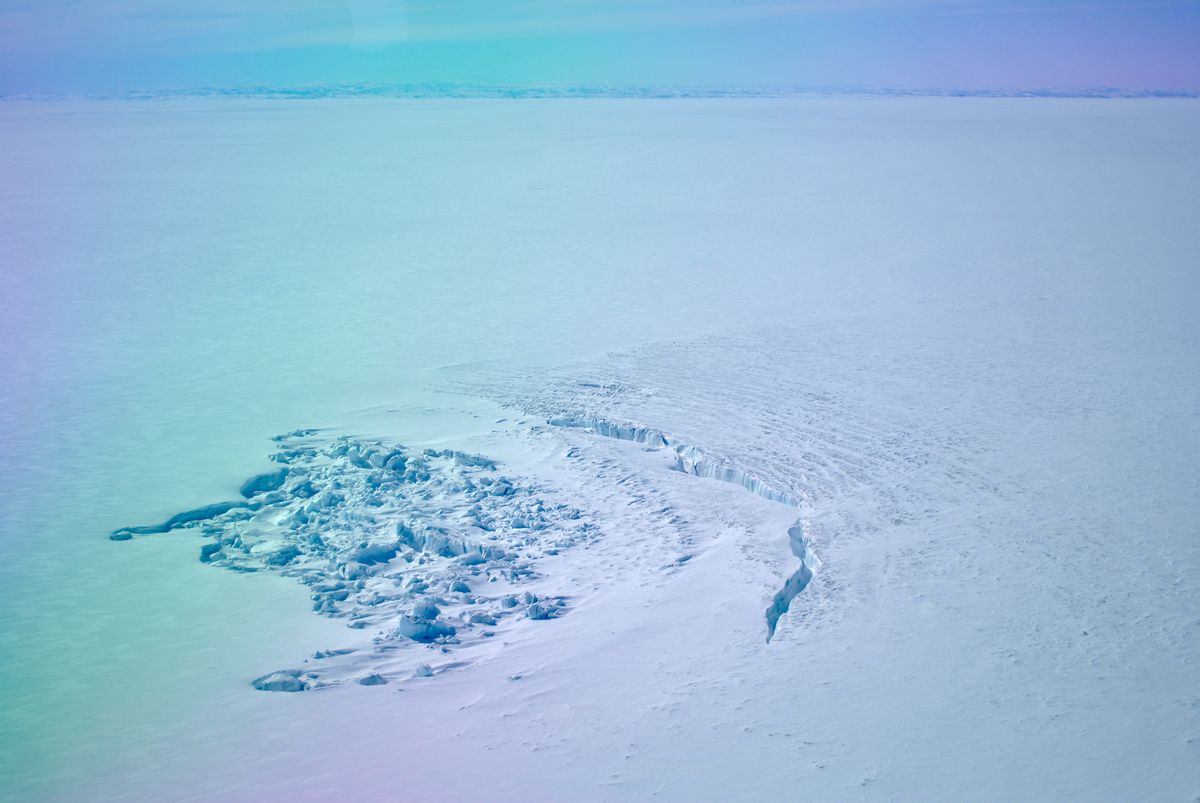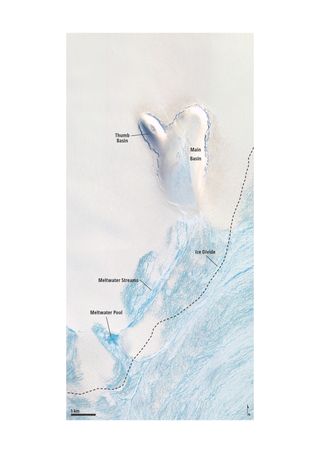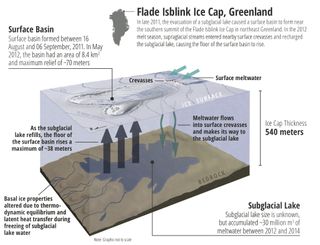New Lakes Discovered Under Greenland's Ice Hint at Warming

The discovery of two large lakes hidden beneath Greenland's ice suggests that climate change now cuts all the way to the bottom of the ice sheet, according to two new studies.
The lakes, on opposite coasts, were only spotted because meltwater from Greenland's surface triggered gushing floods in the fall of 2011. Billions of gallons of water had flushed some 30 miles (50 kilometers) to the sea, leaving behind sunken craters in the surface of the ice above the lakes. Researchers found the fractured ice in high-resolution satellite images and then identified each lake, according to reports published today (Jan. 21) in the journals Nature and The Cryosphere.
The discovery of these lakes will help scientists better understand how Greenland's surface meltwater travels through the ice sheet. And because the water beneath ice sheets can lubricate the movement of glaciers, these newly found lakes and floods may help researchers more accurately forecast how Greenland's ice sheet will respond to future warming. [Image Gallery: Greenland's Melting Glaciers]
"If enough water is pouring down into the Greenland Ice Sheet for us to see the same subglacial lake empty and refill itself over and over, then there must be so much latent heat being released under the ice that we'd have to expect it to change the large-scale behavior of the ice sheet," said Michael Bevis, a geophysicist at The Ohio State University and co-author of the Nature study.

Researchers discovered a lake in northeastern Greenland that has now filled and drained twice since its first blowout in 2011. The mitten-shaped lake is marked by a crater measuring about 230 feet (70 meters) deep. Here, the lake fills with the meltwater coming directly from the ice sheet's surface, trickling downward through cracks in the ice, according to the findings published in Nature.
"This is a new mechanism for getting heat from the top of the ice cap to the bottom of the ice cap, and I think it's likely that we'll see it happening at other places in the future," said Michael Willis, lead author of the Nature study and a glaciologist at Cornell University and the University of North Carolina at Chapel Hill.
The other lake was found after other researchers spotted a crater in western Greenland that could swallow a football stadium, measuring 1.2 miles (2 km) across and 230 feet deep. On satellite images, the lake appeared stable for more than 40 years before draining in late fall 2011, according to the study in The Cryosphere. The scientists estimated that the lake contained about 6.7 billion gallons (about 25 billion liters) of water, enough to fill 10,000 Olympic swimming pools.
Sign up for the Live Science daily newsletter now
Get the world’s most fascinating discoveries delivered straight to your inbox.
"We're flushing more water to the base of the ice sheet and changing the drainage system," Ian Howat, lead author of that study and a glaciologist at The Ohio State University, told Live Science.
Each summer, Greenland's icy surface sparkles with sapphire-blue rivers and lakes that appear as the sun melts the upper layers of snow and ice. But the meltwater typically spends just hours to days at the surface, quickly disappearing from view as it gushes down into cracks and gaping holes called moulins, seeping downward to the rock below the ice. At the edge of the ice sheet, this meltwater reappears, fountaining into the ocean. But somewhere along the journey, some of this meltwater goes missing, studies have found. Researchers have suggested that some of this "missing" surface meltwater might be stored in subglacial lakes.

However, unlike in Antarctica, which has about 400 lakes entombed beneath its thick ice, scientists have found only four subglacial lakes in Greenland, including the two reported today. Although researchers believe there may be more lakes in Greenland awaiting discovery, the number may never equal that of Antarctica because the steep topography in Greenland quickly leads any water out to the sea.
"I think there will be more lakes, but I think that we won't find that these lakes are a major player in the behavior of the large-scale behavior of the ice sheet," said Garry Clarke, a glaciologist at the University of British Columbia who was not involved in the two studies.
The Greenland Ice Sheet covers about 656,300 square miles (1.7 million square km), and the water melting from its surface adds 0.02 inches (0.6 millimeters) to sea level rise each year. Greenland's Arctic region is warming twice as fast as the global average.
Follow Becky Oskin @beckyoskin. Follow Live Science @livescience, Facebook & Google+. Originally published on Live Science.












